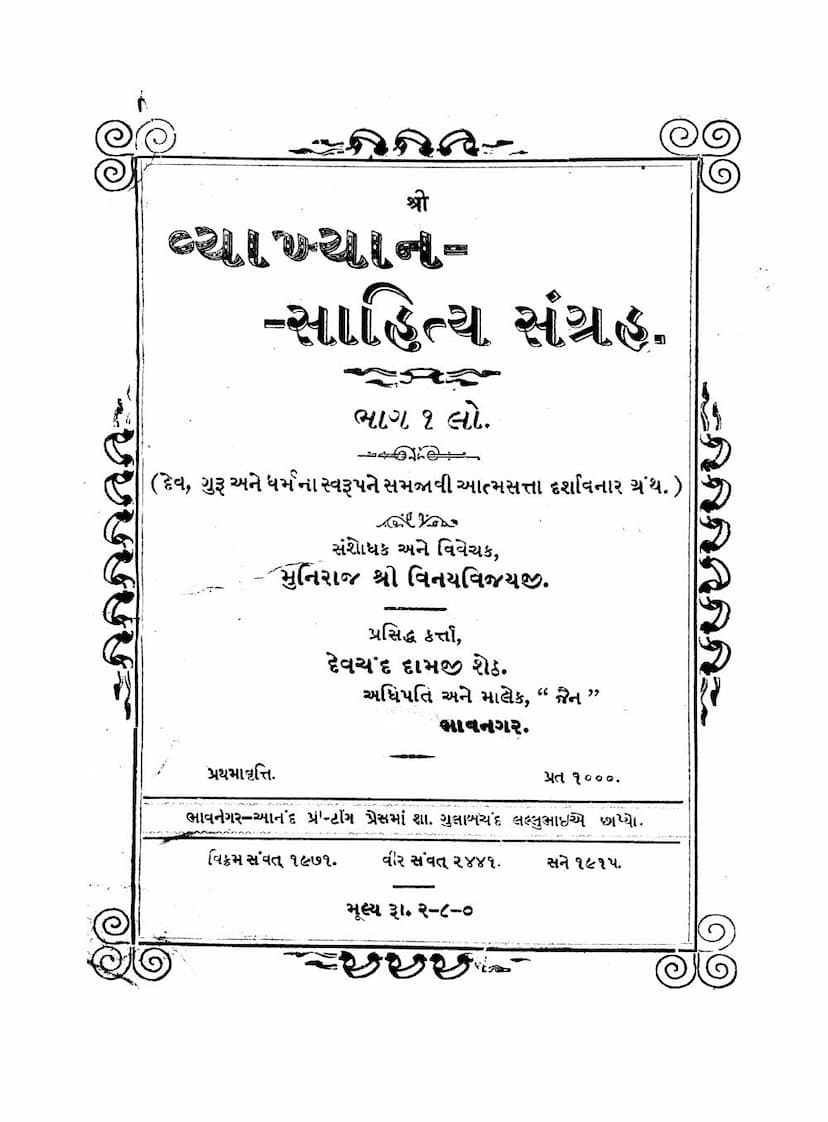Vyakhyan Sahitya Sangraha Part 01
Added to library: September 2, 2025

Summary
Certainly! Based on the provided text snippets from "Vyakhyan Sahitya Sangraha Part 01" by Vinayvijay, here's a comprehensive summary in English:
Book Title: Vyakhyan Sahitya Sangraha Part 01 Author: Vinayvijay Publisher: Devji Damji Sheth Catalog Link: https://jainqq.org/explore/006061/1
Overall Summary:
"Vyakhyan Sahitya Sangraha Part 01" by Muni Vinayvijayji is a collection of discourses and literary analysis primarily focused on elucidating the true nature of the Divine (Deva), the Spiritual Guide (Guru), and the Religion (Dharma) itself, ultimately leading to the realization of the soul's inherent essence (Atma). This volume, as indicated by its subtitle, aims to clarify these fundamental concepts within Jainism and provide a framework for spiritual understanding through various literary and philosophical expositions. The book delves into a wide range of topics, from the attributes of deities and spiritual teachers to the practical aspects of religious practice and ethical conduct.
Key Themes and Content:
The provided text reveals a richly structured compilation that covers a broad spectrum of Jain philosophy and practice. The summaries suggest the following key themes and content:
-
Theology and Spiritual Hierarchy (Deva, Guru, Dharma):
- Deva (Divine): The text begins by explaining the concept of the Divine, likely referring to the Tirthankaras and Siddhas, highlighting their supreme nature, purity, and the essence of their teachings. It discusses the eighteen fundamental virtues to be attained and the thirty-four excellences of Tirthankaras. The worship of Jina idols (bimba) is justified and explained as a means to connect with the divine essence.
- Guru: The importance of the Guru (spiritual guide) is heavily emphasized. The text distinguishes between true Gurus and false Gurus (Kuguru), outlining the essential qualities of a true spiritual teacher, such as detachment, wisdom, compassion, adherence to vows, and the ability to guide disciples towards liberation. The text stresses that true spiritual knowledge and liberation can only be attained through a qualified Guru.
- Dharma: The collection explores the true nature of Dharma, defining it not merely through external rituals but through internal purity, ethical conduct, adherence to principles like non-violence (Ahimsa), truthfulness, non-stealing, celibacy, and non-possession. The ultimate aim of Dharma is presented as the attainment of liberation (Moksha).
-
Ethical Conduct and Virtues:
- The text elaborates on various virtues essential for spiritual progress, including truthfulness, non-violence, purity, contentment, knowledge, meditation, and patience.
- It strongly condemns vices like hypocrisy, greed, anger, ego, lust, and the company of the wicked (Kusang), providing narratives and examples to illustrate their destructive consequences.
- The importance of righteous conduct, self-control, and detachment from worldly desires is repeatedly stressed.
-
The Nature of the Soul (Atma) and Liberation:
- A significant portion of the text is dedicated to understanding the soul's true nature. It describes the soul as eternal, pure, and inherently blissful, distinct from the physical body and the cycle of birth and death.
- The path to liberation is presented as a process of purifying the soul by shedding karmic impurities through virtuous actions, spiritual knowledge, and right conduct.
- The concept of "Tathābhāvyatā" (potentiality for liberation) and its realization through consistent practice is highlighted.
-
Literary and Philosophical Expositions:
- The book is not just a religious treatise but also a rich repository of literary and philosophical analysis. It includes discussions on various poetic meters (Chhanda), using examples from Jain scriptures and classical literature.
- It explains complex philosophical concepts through analogies, stories, and discourse, making them accessible to a wider audience.
- The author, Vinayvijayji, and the publisher, Devchand Damji Sheth, are presented as instrumental in compiling and disseminating this valuable knowledge. The preface also mentions the support of patrons and the community in bringing this work to light.
-
Biographical Information:
- The initial pages include biographical details about Muni Vinayvijayji, tracing his life from his birth in Gujarat, his early spiritual inclination, his philosophical studies, and his dedication to compiling and spreading Jain literature. This provides context for the author's deep commitment to the subject matter.
- It also includes a brief mention of Seth Makhanji Kanji, highlighting his philanthropic contributions which supported the publication of the book.
Structure and Style:
- The "Vyakhyan Sahitya Sangraha" appears to be structured thematically, with each "Parichhed" (chapter or section) focusing on a specific concept or virtue.
- The language is scholarly and comprehensive, using Sanskrit terms and philosophical concepts common in Jain literature, while also employing Gujarati for wider accessibility.
- The author's dedication to presenting a thorough and well-researched work is evident through the detailed explanations, scriptural references, and poetic verses used for illustration.
Overall Purpose:
The book aims to educate, guide, and inspire readers towards a deeper understanding and practice of Jainism. It seeks to clarify spiritual truths, emphasize ethical living, and provide a roadmap for achieving liberation by understanding the true nature of the divine, the guru, the dharma, and the soul.
This summary integrates the information gleaned from the provided page snippets, presenting a comprehensive overview of the book's likely content and its significance within Jain religious and literary traditions.